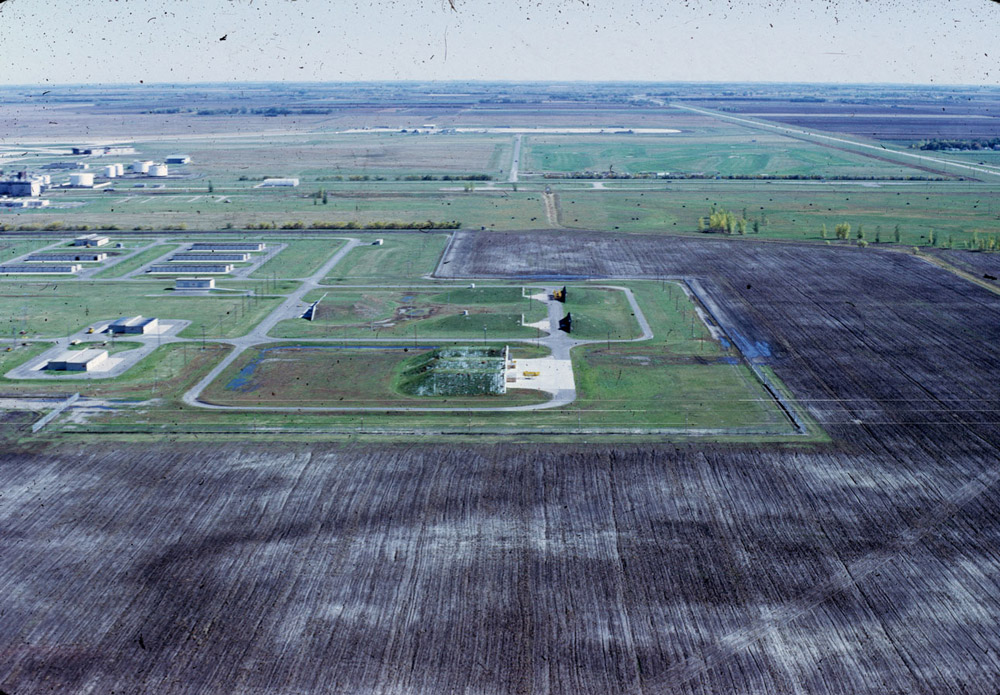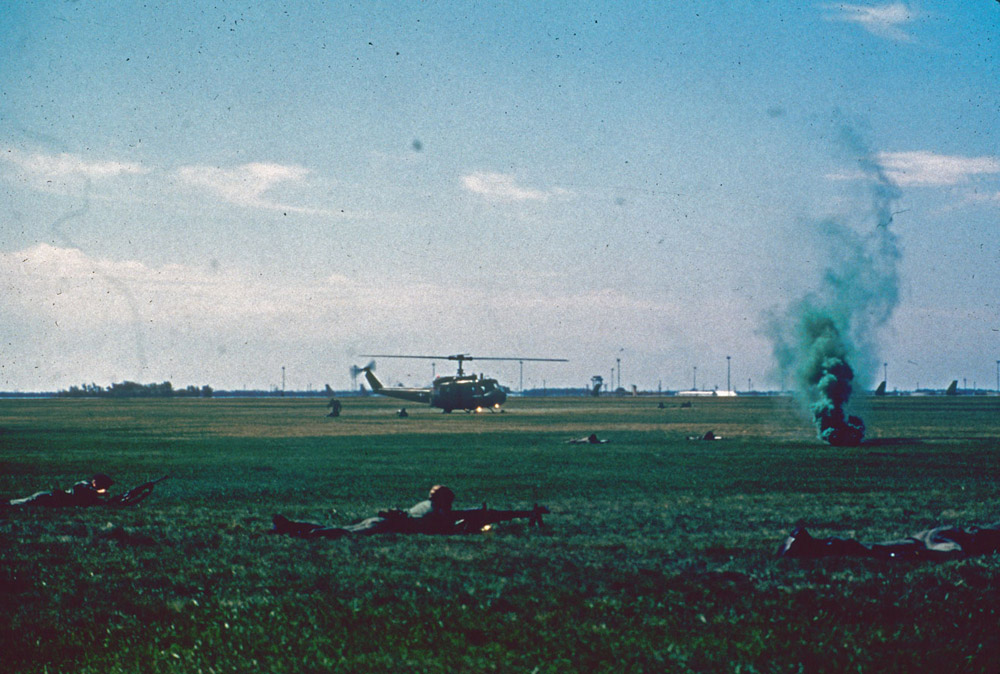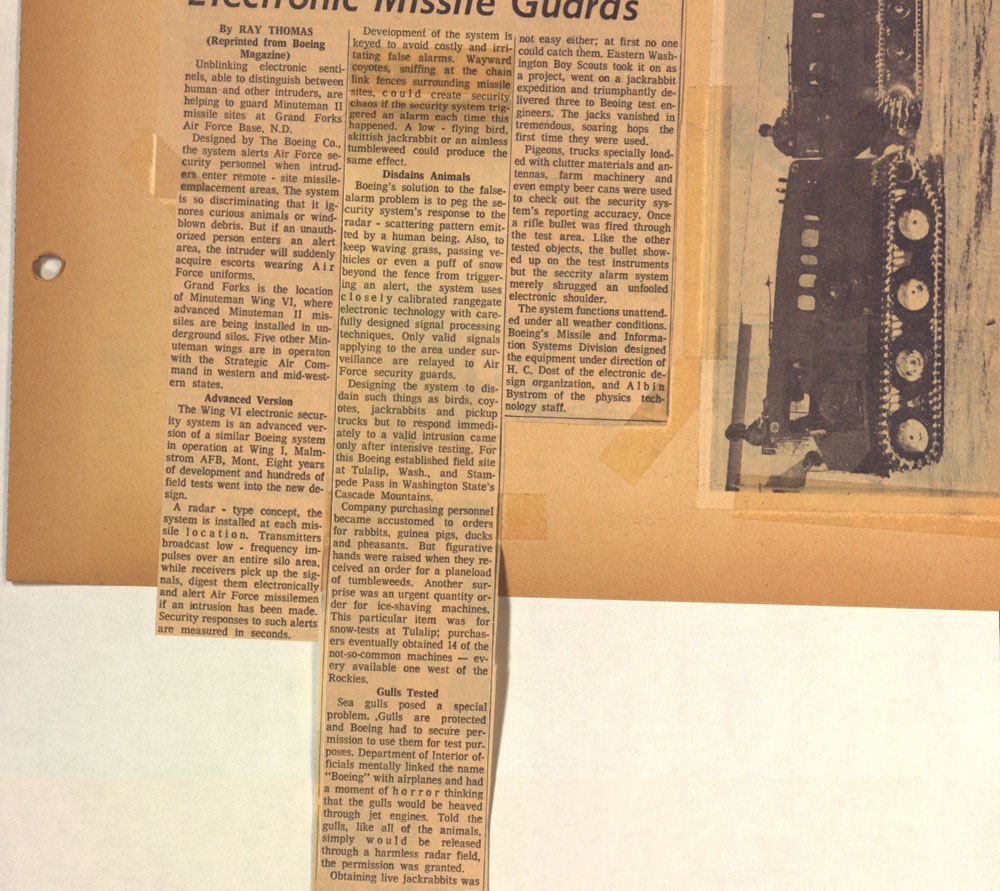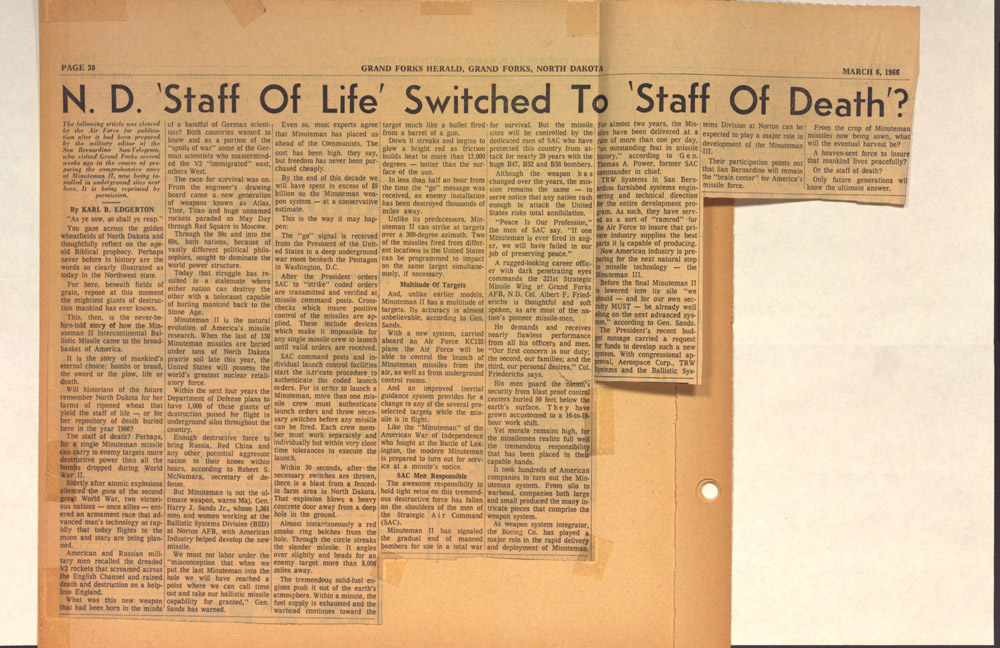North Dakota was one of the battlegrounds for the Cold War (1950s through the 1980s). With more than 300 Inter-continental Ballistic Missiles (ICBMs) and 30 anti-ballistic missiles (ABMs), North Dakota was both well-armed and a prime target for enemy attack. Fortunately, none of these missiles was ever fired, and half of them were removed in the 1990s.
-facility-optimized.jpg)


No one could ignore the facts of the Cold War. Russia constantly threatened the security of the United States. In October, 1960, Premier Nikita Krushchev of the Soviet Union promised all western nations that Communism would outlast western democracies. Americans understood that statement as a serious threat.
North Dakotans had many different ideas about the missiles in our backyard. Some were happy that the United States had developed an effective system of defense. Others did not want farmland contaminated by nuclear fallout (the radioactive material that fell from the skies after a nuclear warhead was detonated). Many North Dakotans learned to ignore the activity surrounding the missile silos and Missile Alert Facilities (MAFs). (See Image 1.)
Merl PaaverudMerl Paaverud also remembered “duck and cover” exercises at school. “In school we did the ol’ get under your desk and cover your head in case of nuclear attack.” He laughed saying that, as he thought about how little protection a desk would offer against nuclear bombs. After high school, Merl Paaverud entered the Air Force. After military service, he graduated from the University of North Dakota. He went to work for the State Historical Society, and today he is director of the State Historical Society. Paaverud was interviewed June 27, 2012. SHSND Mss 32314 grew up on a farm near Finley. He was in high school when the missile silos were being installed near his home. The missiles were “really an economic boon for the area. . . . If you could weld . . . you could get a job. [There was] a great impact on the economy. . . . Farmers were farming around the missile sites and launch control centers so . . . [the sites] became part of the environment.” (See Image 2.)
The presence of missile sites raised the community’s awareness of the Cold war. “It was on your mind,” Paaverud said. “You didn’t worry about it, you didn’t expect one day to be on your tractor digging and looking back and seeing the smoke coming out of [the silo], either. It never happened, but it could have happened.” Paaverud remembered some neighbors who opposed the missile fields, but “the majority of people were interested and supportive of defense.”
Shirley NorgardShirley Norgard was a young mother and farm wife when the missile sites were being installed near their Cooperstown farm. She was interviewed on August 12, 2010. SHSND Mss 32314 also remembered the installation of missile silos near her farm home. Norgard remembered people talking about building fallout shelters in their basements. But people also recognized that “If they actually bombed us what would there be to come out [of the fallout shelter] to?” Norgard found that missile facilities were not the best neighbors. She recalled a day when a local man got stuck on the road in a blizzard. He went to the gate of a MAF to get some help, but the airmen were under orders to refuse entrance to anyone. He was turned away. Norgard thought that anyone else would have given shelter to the stranded man. (See Image 3.)
The missiles in the Grand Forks and Minot missile fields were not dangerous to the people who lived nearby. They could not detonate in the silos. The missiles were only dangerous if the Soviet Union attacked the missiles. Many people thought the Safeguard Complex at Nekoma was more dangerous than the ICBMs in their silos. The missiles at Nekoma were designed to explode as enemy missiles approached the Grand Forks missile field. The ICBMs would be protected, but the fallout from a defensive nuclear explosion would poison people and destroy farmland. Hundreds of people, including scientists and politicians criticized the Safeguard Complex. They called the consequences unacceptable. Governor William Guy did not believe that the Safeguard Complex was good for North Dakota’s economy. Senator Quentin Burdick also opposed the Safeguard Complex.
The missile silos and the Safeguard Complex were the scenes of occasional peaceful protests. Military officers made every effort to secure the sites before a protest event, so there would be no confrontation or conflict during a protest.
Many young North Dakotans who grew up with a strong military presence in their neighborhoods chose to enter the Air Force in the 1960s and 1970s. Merl Paaverud enlisted in the Air Force. For many North Dakotans, service in the Air Force offered many good opportunities.
Some welcomed the missiles as a part of the nation’s defense system, and others disliked the impact of the missile defense system on the state. However, most North Dakotans became accustomed to seeing the big fences that seemed to contain nothing. It was our part to play in the Cold War. (See Document 1.)
Why is this important? North Dakota’s history did not prepare us to be the center of Cold War events. A place where people farmed and helped their neighbors was an unlikely place for 300 of the world’s most terrible weapons. In some ways, the presence of missiles changed North Dakota. The Cold War brought a small burst of economic growth to the state and placed us in the center of world affairs. However, many North Dakotans refused to let missiles change the way they lived. They did not give in to the politics of fear. They continued to be hard-working, thoughtful of their neighbors, patriotic, and tolerant of others.
Visit the Ronald Reagan Minuteman Missile Site: http://history.nd.gov/historicsites/minutemanmissile/






